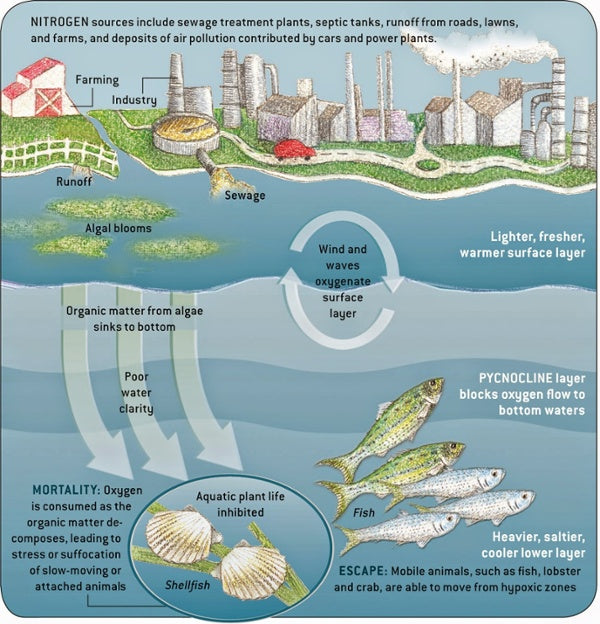
The 7 Biggest Threats to Our Oceans: Threat #4 Dead Zones
What is a “dead zone”? The term dead zone is a common name given to an area in the ocean that is hypoxic, meaning it is an area with such low oxygen concentration that animal life cannot survive or thrive within it. The result, areas of the ocean that were once abundant with life, become biological, barren deserts.
While dead zones can occur naturally in any body of water, a major cause is from excessive nutrient pollution from humans, coupled with other factors, such as algae blooms, that deplete the oxygen required to support marine life with in the water.
Here is how it works…nutrients from agricultural and urban developments are washed into a body of water in excessive amounts. At normal levels, these nutrients feed organisms called blue-green algae, and phytoplankton. However, with an overabundance of nutrients such as nitrogen and phosphorus, these organisms rapidly grow out of control, and suck up all the available oxygen within the ecosystem. Eventually they too die and sink to the bottom where they are decomposed by bacteria. This decomposition process also consumes oxygen, further depleting the supply available to the other marine life.
Low oxygen levels radically change the ecology of coastal ecosystems. When oxygen becomes scares, creatures such as fish, shrimp, and crabs, are able to vacate the area and move to a more suitable habitat. Unfortunately the less mobile marine creatures such as sea plants, worms, and clams that are rooted in the seabed, are unable to escape the toxic hypoxic water, and die off after extended exposure. As oxygen concentration decreases, these sediment dwelling organisms decline in number and ecosystems loose diversity and overall water quality. In addition, dead zones are the cause of massive shifts within the food chain, therefore threatening fisheries that the economy and many humans depend on.

So, what is the diagnosis for our suffocating seas and how can we all help breathe some life back into them? Great news is, is that scientists are confident that this phenomena can be reversed! The solution to manmade dead zones is one that will also relieve many other ailments of the sea, cleaning up our oceans!
If we were to implement better practices of how we discharge chemicals, use less fertilizers on our agricultural lands, and find alternative methods for sewer systems that don’t involve releasing waste into the ocean, there is a good chance for dead zone recovery. By doing this, it would limit the runoff that flows into our oceans and feeds the problem algae.
When you support and consume from companies that practice green, eco-friendly practices, and concentrate on giving back to the environment, you are making an impact on the quality of our oceans. You can also get involved with a local beach clean-up, and reduce the amount of chemicals and fertilizers you use around your home. By being mindful with our day to day choices, being aware and spreading awareness of the situations making our seas sick, and doing what you can, will all make a positive impact. If we start today, the oceans will be a better place in the future.






Leave a comment
This site is protected by hCaptcha and the hCaptcha Privacy Policy and Terms of Service apply.